Systems
What is a System?
A system is an entity that maintains its existence through the mutual interaction of its parts, and each element is a system unto itself. All life forms are systems, but there are also inorganic systems too. Earth systems involve the interactions between energy flows, matter cycles, and life webs. You could also consider how the atmosphere (gases), biosphere (life), cryosphere (ice), geosphere (rock), and hydrosphere (water) interact. Both are useful ways to think about how the Earth’s system has developed and supported complex life over much of its 4.5 billion years of existence. With each component you study, the complexity of the system becomes more apparent.
If you are familiar with systems, click the button to run the Predator/Prey Systems Model. There is supporting information about systems and another button for the app below.
Studying systems provides:
- A way to look at the big picture while also considering the details.
- An essential framework for observing and measuring patterns and trends.
- A perspective to understand and predict its behavior to changing conditions.
- A useful structure to identify cause and effect relationships.
- A platform to test assumptions of the system either through models or conjecture.
Feedback Processes
Since systems contain interconnected processes, sometimes a feedback loop occurs in which the output of a process circles back to become the input. Positive feedback occurs when the processes within the feedback loop amplify the response to a change in the system, pushing it toward an extreme condition. Other times, negative feedback occurs, so a perturbation in the system creates a balanced, stable response that is not a severe condition.
In today’s world, we use the terms positive and negative feedback in many ways that can make this confusing to remember. For example, positive feedback at school is welcome, whereas positive results for a medical test can be quite scary.
Many of us have experienced positive feedback whenever we’ve heard a blaring/screeching sound coming from a microphone-speaker system. Microphones convert sound to electrical signals that are amplified and sent to a speaker. If the receiver is close enough to the speaker to detect the amplified sound, then the system increases the already amplified sound. The amplification continues this in a positive loop, and we hear a loud, painful noise coming from the speaker (see concept map of this positive feedback above).
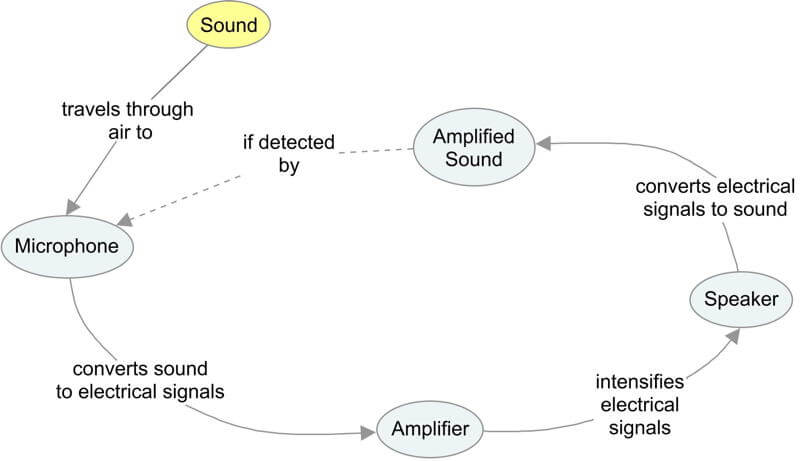
This is a concept map of how positive feedback in a microphone system creates a screeching sound when the mic gets close to the speaker. A suggested place to start studying the concept map is highlighted in yellow.
Practice interpreting concept maps with a quiz of different concept maps that provide feedback on your answers.
Feedback in Earth Systems
Earth’s system has many feedback loops, many of which create negative feedback that help Earth maintain a moderate range of climate response to changes in the system. But there are some positive loops within the system that can create dramatic, if not extreme, conditions on Earth. One is the Arctic or polar amplification (concept map on right). Snow forms in cold conditions, and if the temperature stays below freezing throughout the year, ice may form from the snow. Both ice and snow reflect most of the Sun’s radiant energy, so the region becomes colder, which allows snow and ice to form at lower latitudes. Ultimately the ice extends further and further from the poles over time. Conversely, if the climate warms, snow and ice melt during the summer months, exposing either land or water. Both materials absorb most of the sunlight, so the region warms more, melting more snow and ice in the region, and the ice retreats toward the poles.
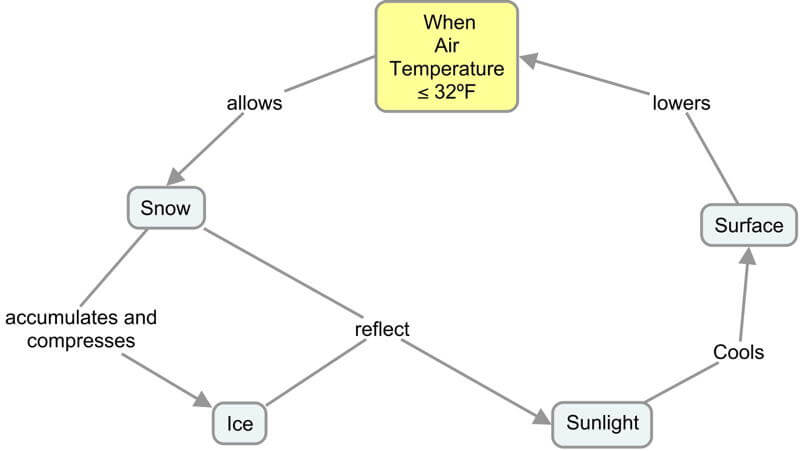
Concept map of the Arctic Amplification, which is positive feedback that can quickly cool a polar region. A suggested place to start studying the concept map is highlighted in yellow.
Research and Prediction
Studying the Earth as a system allows us to identify positive and negative feedback loops, helping scientists improve their research of how Earth has responded and will respond to changing conditions on Earth through time. Consider using concept maps as a tool to visualize positive and negative feedback within a system.
Acknowledgments
Mattea Horne’s suggestions significantly improved the concept maps on this page.
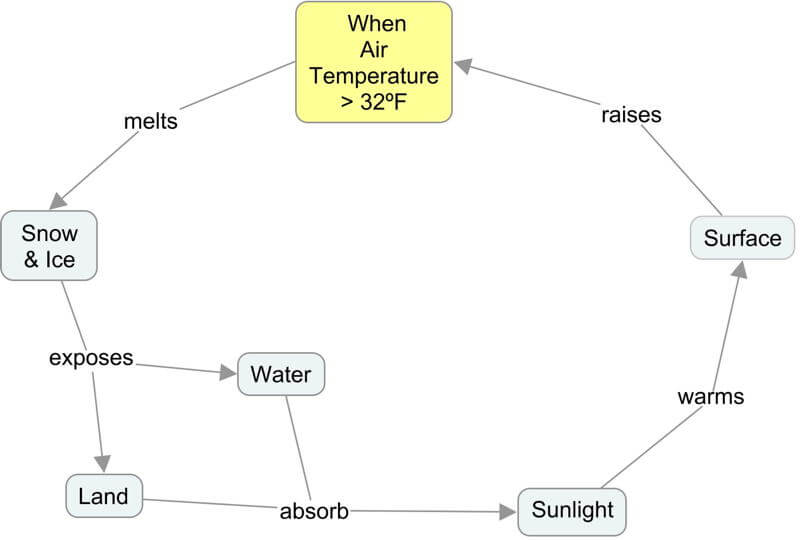
Reversing the concept map of the Arctic Amplification predicts that when the Arctic begins to warm, there is positive feedback too. We are seeing this rapid warming in the polar regions during the late spring through summer months. A suggested place to start studying the concept map is highlighted in yellow.
Activities
You as a System
1) Parking lot the systems that make you (explore Concept Mapping to familiarize yourself). Expand your focus beyond your biological systems. Consider your educational, social, and support systems as well.
2) Connect the systems and add verbs to the links that describe how one system affects another.
3) Brainstorm how an individual makes up systems larger than themselves.
Explore a Model of a System
Animals and plants interacting together as a life web also create a system. In this predator-prey model, grass, rabbits (although they look like raccoons!), dragons, and human hunters interact over time.
Click the button to run the Predator/Prey Systems Model.
Change populations and see if individuals remain for each of the species after 1000 iterations (displayed in the “Clock / Results” data window. If one or more populations die off before 1000 iterations, the system has crashed, and the model stops. You may increase the engine speed to run the system faster.
Step 1) Select the starting populations of rabbits, dragons, and hunters.
Select the minimum energy level for reproduction for grass, rabbits, and dragons. For reference, when created, grass has an energy of 2, a rabbit has 3, and a dragon has 8.
Step 2) Click “Setup / Reset” to view the populations. NOTE: If the population area is behind the sliders or graph or too small, click “Edit Camera” and move the image or expand it.
Step 3) Click “Play / Stop,” so the populations interact.
The size of individuals is proportional to how much energy it has. Animals move faster when they have more energy (larger), and slower when they are smaller.
Experiment to see how life forms interact, in particular, how energy flows from plants to herbivores to carnivores. To reset the populations for another experiment, click “Setup / Reset.”
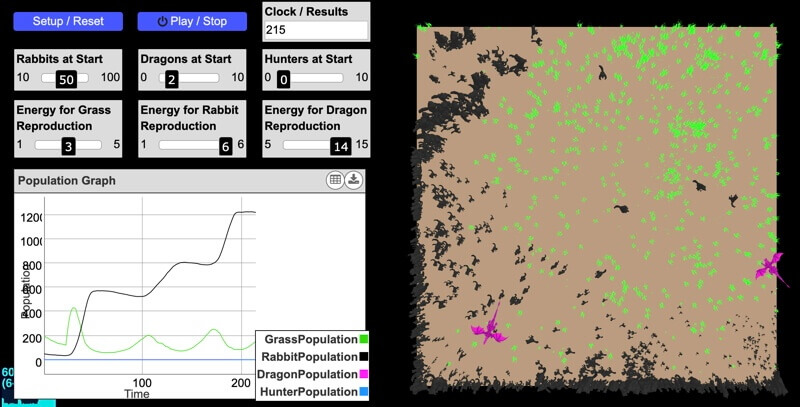
Above is a screenshot of the interactive System Model, which is a predator-prey model involving grass (green), rabbits (black), dragons (magenta), and hunters (optional and are blue). Use the sliders to change the starting populations and how each species reproduces based on their energy levels. Create experiments to see if the system lasts 1000 iterations or whether it crashes.
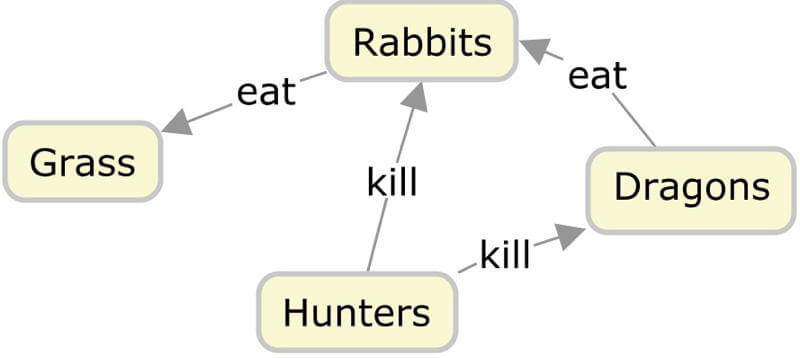
Above is a simple concept map of the systems model.
Parachuting Cats?
Read Parachuting Cats and identify the components described in the story. If possible, work in teams of two or three and discuss each list’s strengths.
Next, create a concept map of the system before the use of DDT. Identify the components that changed with the use of DDT. Using a concept map as a predictive tool is an example of how understanding a system can help identify unintended consequences by an external process. As we saw in Borneo, when a system’s components are highly interconnected, a change to one part often creates changes throughout the system.
These materials focus on Earth’s system without the influence of humans. Still, if you understand this system, it is easier to understand how Earth responds to the profound changes humans are creating.
On the right is a concept map illustrating the influence of energy exchange and regulation on the interacting life forms in the System Model.
Notice the positive feedback between consuming energy (food) and population growth. The more a population can eat, the more it can reproduce, which then consumes more of the food supply. If the population increase is unchecked, the food source could disappear, causing a catastrophic collapse of the system.
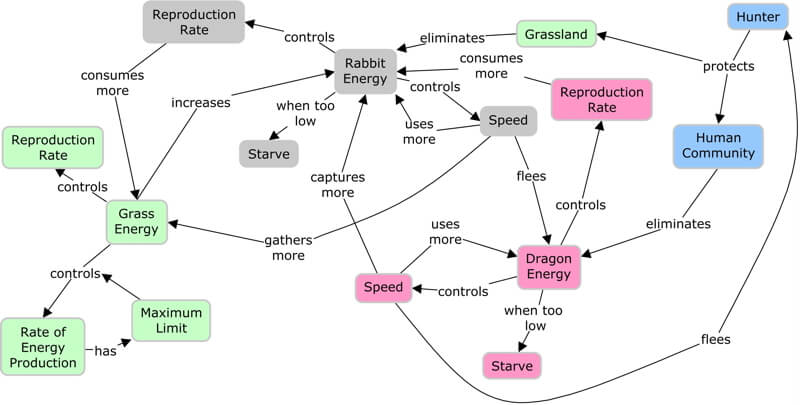
Above is a more complex concept map of the grass-rabbit-dragon-hunter model. This version focuses on the energy of the components in the system.
Big Ideas
- Everything is part of a system.
- Studying systems helps us understand and predict how a system responds to changes acting on and within the system.
Articles Providing an Overview of Earth Systems Science
Earth Systems Science in a Nutshell

0 Comments